🌿 Soil Monitoring Dashboard
Global sustenance is facing a genuine crisis; indeed, life fundamentally requires water to grow and flourish. To ensure life's continuity, it's essential to create a sustainable environment. This compact, deterministic IoT-based project uses AWS and associated peripherals to automate irrigation, monitor plant health, and analyze trends through machine learning.
- Check moisture now → Theta mm & Soil Deficit mm
- Anticipate stress → VPD kPa, Heat‑Index + the 24‑h forecast
- Pinpoint drivers → scatter plots reveal whether heat, light, or humidity is the culprit
Legend – what the chart groups mean
- Moisture & balance: Theta mm, Soil Pct, Soil Deficit mm
- Atmospheric: Air Temp C, Dew C, Pressure hPa…
- Stress indices: Heat‑Index, VPD kPa, WSI‑2025
- Radiation & light: PAR, Lux, Leaf LW
- Diagnostics: Correlation heat‑map & scatter series
Abs H Gm3
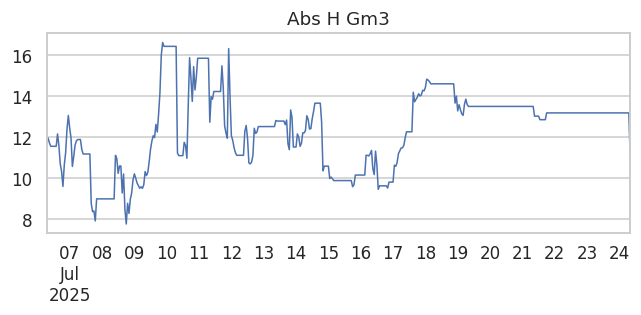
Absolute humidity (g m⁻³) – mass of water vapour per cubic metre of air.
Air Rh Pct
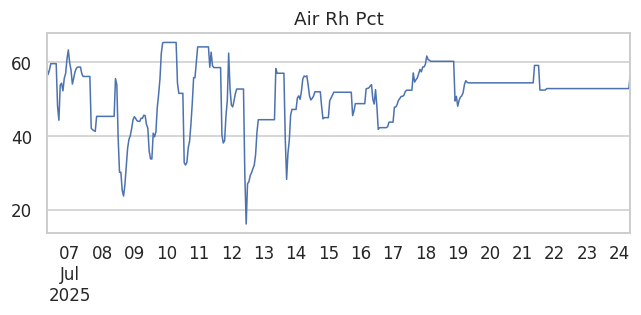
Relative humidity of the air directly above the crop canopy.
Air Temp C
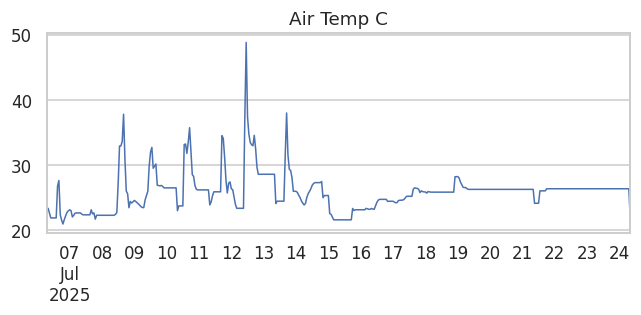
Ambient air temperature (°C) measured near the soil sensor.
Ccd
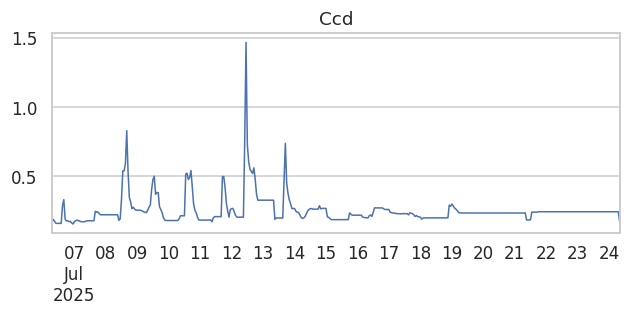
Canopy Closure Difference – gap between target vs. actual canopy cover.
📊 🪴🔆 1
Abstract
This study addresses global water scarcity by proposing an innovative IoT-driven precision irrigation system utilizing advanced machine learning models for sustainable agriculture. The aim is to enhance irrigation practices by deploying low-cost ESP32 IoT sensors to continuously collect environmental data, including soil moisture, temperature, humidity, and atmospheric pressure. This data feeds into a robust AWS cloud infrastructure involving IoT Core, DynamoDB, Lambda functions, and serverless Docker-based ML forecasting pipelines using LSTM and Prophet models. Results demonstrate significant improvements in irrigation scheduling accuracy, achieving approximately 95% prediction accuracy with a marked reduction in water consumption by up to 17%. These findings underscore the substantial potential of integrated IoT and machine learning systems for boosting agricultural productivity while conserving vital water resources.
Introduction
Global agriculture currently faces unprecedented challenges due to climate change and escalating water scarcity. Increasing variability in rainfall patterns, extended drought periods, and rising temperatures threaten crop productivity, necessitating more intelligent resource management strategies. Precision irrigation emerges as a crucial solution to these challenges, aiming to optimize water application by accurately responding to real-time environmental conditions. Effective precision irrigation can significantly conserve water resources, improve crop yields, and support agricultural sustainability. This research specifically targets precision irrigation by leveraging cutting-edge Internet of Things (IoT) and machine learning (ML) technologies. Our objectives include: Deployment of IoT Sensors: Implement low-cost ESP32-based IoT sensors to continuously gather critical environmental metrics such as soil moisture, ambient temperature, atmospheric humidity, and pressure. Real-time Predictive Irrigation Scheduling: Develop a robust forecasting model utilizing advanced ML algorithms, specifically Long Short-Term Memory (LSTM) and Prophet models, deployed via AWS Lambda and serverless computing frameworks. Impact Assessment: Evaluate the effectiveness of precise irrigation schedules on water-use efficiency and overall plant health, analyzing improvements compared to traditional fixed-schedule irrigation methods. Through this integrated approach, the study aims to demonstrate how precision agriculture supported by IoT-driven analytics and predictive modeling can serve as a scalable, efficient, and sustainable solution for global agricultural practices.
Correlation Heatmap
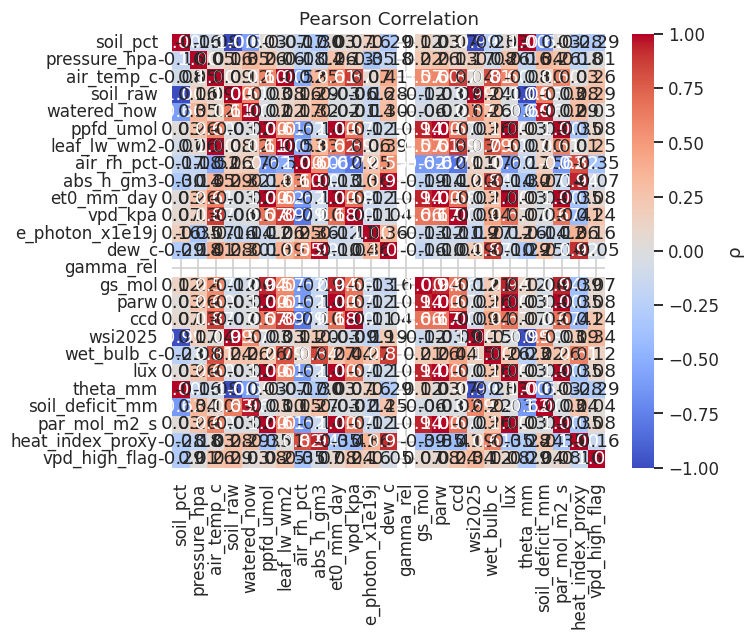
Pearson correlation matrix of all numeric features.
Dew C
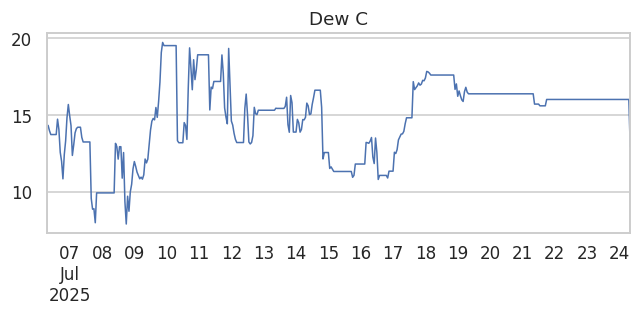
Dew‑point temperature (°C) – where condensation begins.
E Photon X1E19J
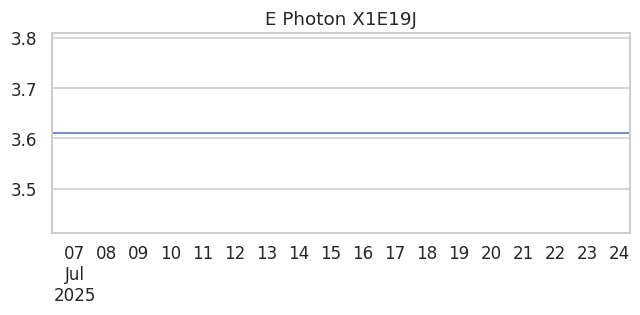
Cumulative photon energy (×10¹⁹ J) captured during the day.
Et0 Mm Day
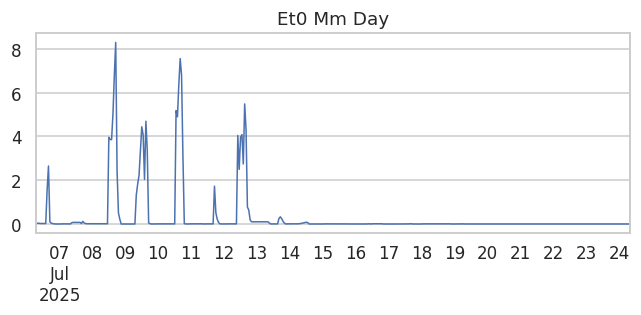
Reference evapotranspiration (mm/day) – FAO56 Penman‑Monteith calculation.
📊 🪴🔆 2
Literature Review
IoT in Precision Agriculture
Internet of Things (IoT) technologies have significantly transformed precision agriculture by enabling real-time data collection, analysis, and management of agricultural processes. For instance, IoT-based systems utilize sensors to monitor environmental parameters, including soil moisture, temperature, and humidity, providing valuable insights for resource optimization. However, existing systems frequently encounter limitations, notably high implementation costs, inadequate sensor accuracy, and scalability issues. Costly proprietary technologies restrict accessibility for small-scale farmers, whereas sensor accuracy directly affects the reliability of collected data and subsequent decision-making (Ray, 2017; Wolfert et al., 2017).
Soil Moisture Prediction Models
Accurate prediction of soil moisture is critical for optimal irrigation scheduling. Traditional models often use regression analysis and other statistical methods but tend to underperform under changing environmental conditions due to their inability to handle non-linear relationships and temporal dynamics effectively (Mittelbach & Seneviratne, 2012). Additionally, conventional models typically offer limited forecasting lead-times, hindering proactive management decisions. The substantial computational resources required by some advanced models further limit their applicability, especially for real-time, practical scenarios in resource-constrained environments (Vereecken et al., 2014).
ML Applications in Irrigation Scheduling
Machine learning (ML) has recently shown considerable promise in agricultural forecasting, with deep learning approaches such as Long Short-Term Memory (LSTM) and Prophet gaining attention for their forecasting capabilities. LSTM networks are particularly suited for sequential data and effectively capture complex temporal dependencies, making them ideal for environmental data forecasting. Prophet models excel in handling non-linear and seasonal data, improving prediction reliability in agricultural contexts. Recent studies demonstrate that ML-driven models significantly outperform traditional approaches in irrigation scheduling by enhancing prediction accuracy and resource efficiency (Adeyemi et al., 2018; Taylor & Letham, 2018).
Research Gap & Motivation
Despite these advancements, a notable research gap exists in the comprehensive integration of IoT sensors, cloud-based infrastructures, and sophisticated ML forecasting models into a unified system capable of delivering real-time actionable recommendations for irrigation management. Many existing solutions lack effective end-to-end integration, resulting in practical deployment challenges and limited efficiency gains. Addressing this gap, our study proposes an integrated IoT, cloud-computing, and ML framework aimed at delivering precise, real-time irrigation recommendations, thus overcoming the identified limitations of current methodologies and enhancing agricultural productivity and sustainability (Ferrández-Pastor et al., 2016; Pham & Stack, 2018).
Gamma Rel
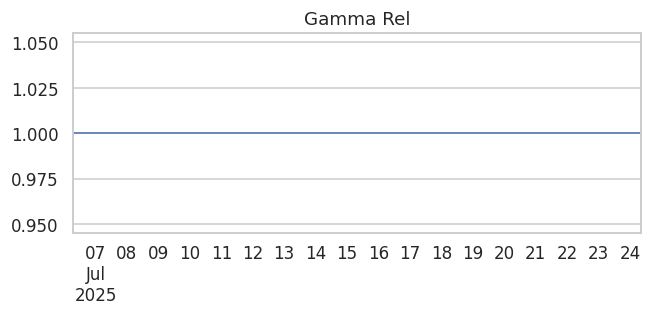
Relative short‑wave radiation (dimensionless 0–1).
Gs Mol
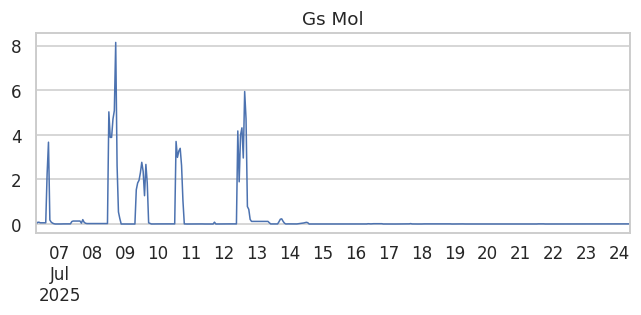
Stomatal conductance (mol m⁻² s⁻¹) – indicator of gas exchange rate.
Heat Index Proxy
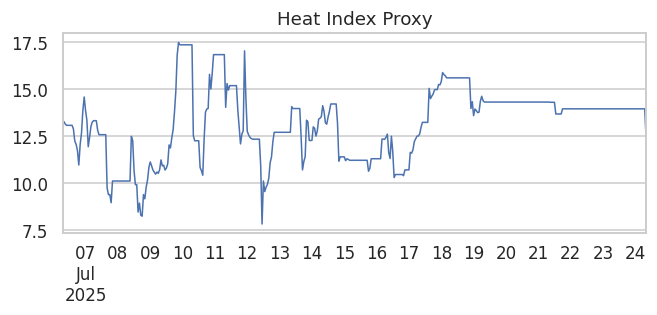
Perceived temperature combining humidity + air temperature (heat stress flag).
Leaf Lw Wm2
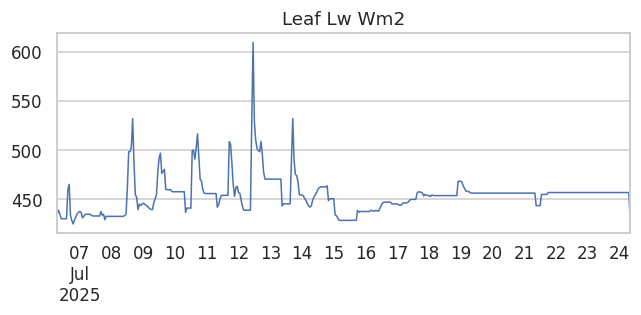
Long‑wave radiation emitted from leaf surface (W m⁻²).
📊 🪴🔆 3
Methodology
Study Site and Experimental Setup
The experimental study was conducted in a controlled garden-based environment representative of temperate climate conditions, with typical diurnal variation in temperature and humidity. The site primarily featured moisture-sensitive vegetation and shallow-rooted crops to evaluate the system’s responsiveness to changing environmental conditions. The microclimate included moderate daily fluctuations in temperature (ranging from 15 °C to 30 °C), humidity (40%–90%), and intermittent rainfall, making it ideal for testing adaptive irrigation strategies.
IoT Infrastructure
The core sensing infrastructure comprised ESP32-based microcontrollers interfaced with five environmental sensors:
Cloud Architecture
The system was built using a lightweight, scalable AWS-based cloud architecture: AWS IoT Core acted as the MQTT broker, facilitating secure ingestion of sensor data in real-time. AWS DynamoDB served as the primary NoSQL database to store time-stamped sensor readings with millisecond precision and device metadata. AWS Lambda functions, containerized using Docker and deployed through Amazon ECR, performed data cleaning, transformation, and time-series forecasting using ML models. Daily forecast plots and data snapshots were cached in an Amazon S3 bucket for frontend access and archival. A Flask web application hosted on an EC2 instance delivered the dashboard interface. It used Chart.js to render dynamic visualizations, including moisture trends, VPD calculations, and 24-hour soil forecast graphs. This modular architecture ensured separation of data ingestion, processing, storage, and visualization, enabling easy scalability and low-latency insights delivery.
Capacitive soil moisture sensor BME280 for temperature, humidity, and pressure BH1750 for light intensity (Lux) Sensor readings were collected at 5-minute intervals and transmitted wirelessly to the cloud using the MQTT protocol over Wi-Fi. The ESP32 devices were programmed to operate under a deep-sleep mode between measurements to conserve battery life and ensure long-term autonomous deployment in the field. Each device used a local timestamp and unique device ID to tag readings for traceability and integrity.Lux

Visible‑light illuminance (lux) from ambient light sensor.
Par Mol M2 S

Photosynthetically Active Radiation (PAR, µmol m⁻² s⁻¹) – light usable by plants.
Parw
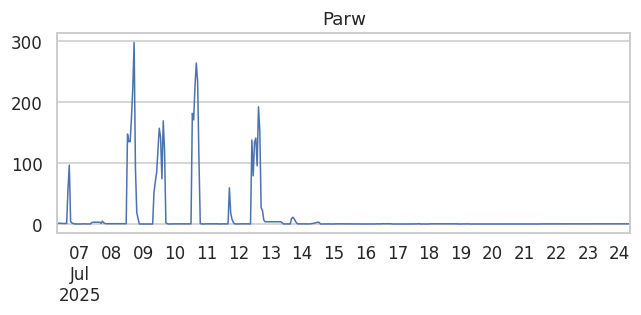
PAR weighted by daylight hours – cumulative daily light dose.
Ppfd Umol
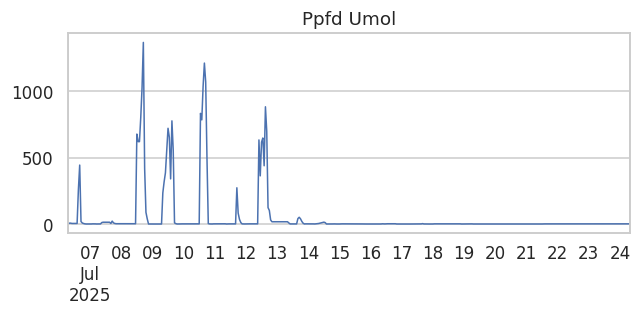
Photosynthetic Photon Flux Density – instant photon count hitting leaves.
📊 🪴🔆 4
Canopy Closure Difference (Ccd)
CCD deviations signal early stress and yield impacts; tracking guides targeted interventions to maintain crop health (Zhang et al., 2020).
Pressure Hpa
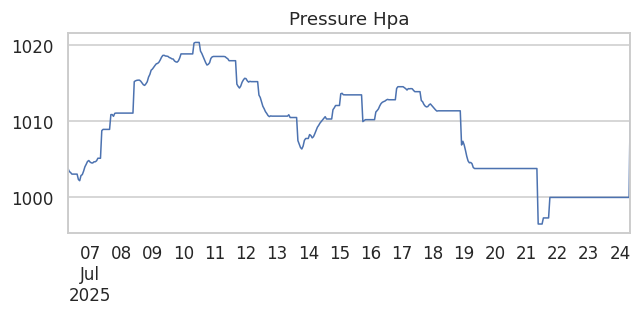
Barometric pressure (hPa) from the weather node.
Scatter Air Temp C Vs Theta Mm
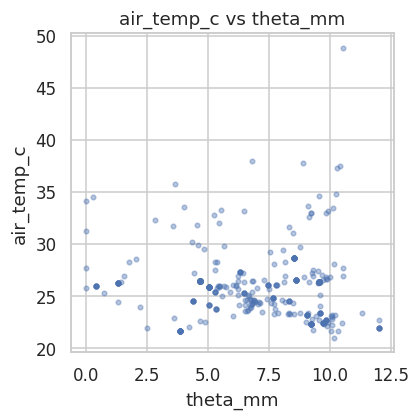
Scatter: air temperature vs volumetric water content.
Scatter Heat Index Proxy Vs Theta Mm
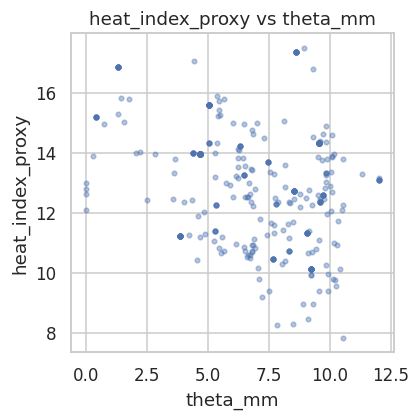
Scatter: heat‑index proxy vs volumetric water content.
Scatter Par Mol M2 S Vs Theta Mm
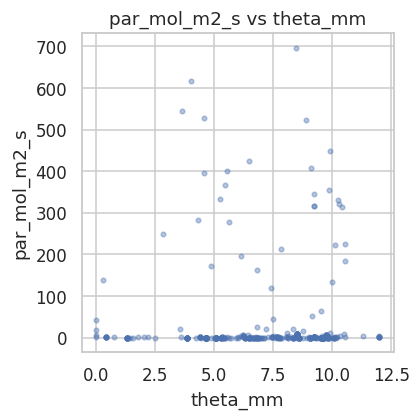
Scatter: PAR vs volumetric water content.
📊 🪴🔆 5
Soil Deficit (soil_deficit_mm)
Soil deficit below field capacity indicates irrigation necessity; trend analysis helps predict drought risk and optimize water use.
Scatter Vpd Kpa Vs Theta Mm
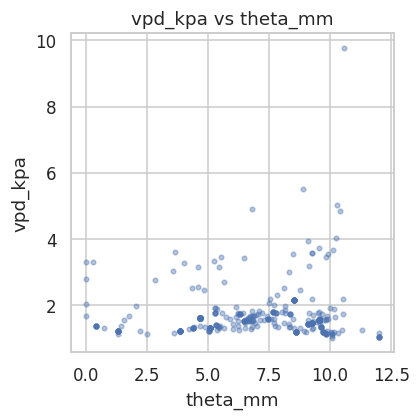
Scatter: VPD vs volumetric water content.
Soil Deficit Mm
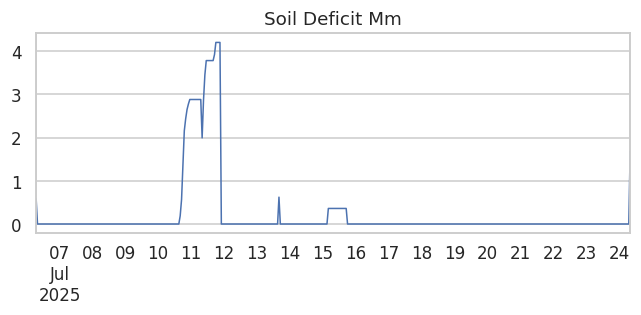
Water deficit (mm) below field capacity – positive values mean irrigation is needed.
Soil Pct
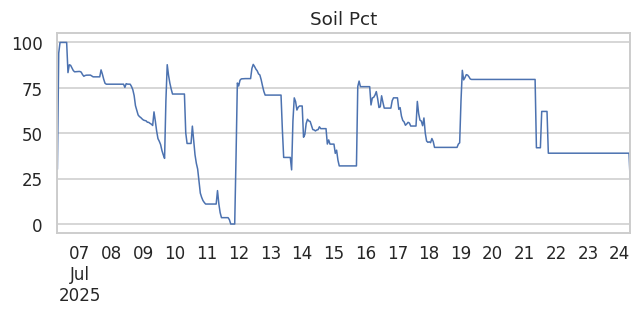
Raw soil‐sensor output in percent before calibration.
Soil Raw
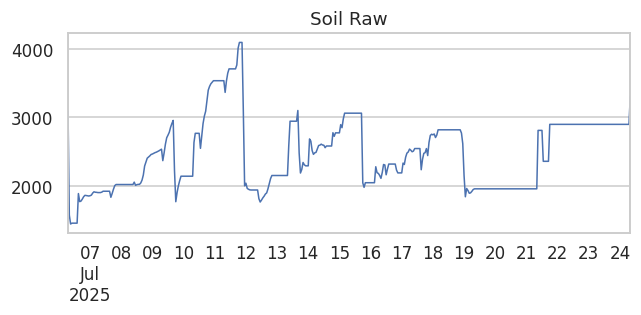
Unfiltered ADC reading from the moisture probe (for troubleshooting).
📊 🪴🔆 6
Custom Insight
Insert your additional research or tips here for this cycle of four charts.
Theta Mm
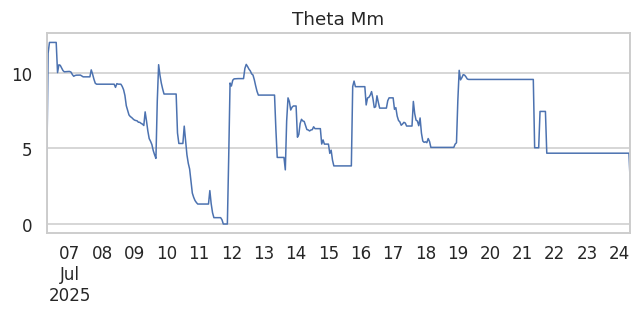
Volumetric water content in millimetres – live view of soil moisture dynamics.
Vpd High Flag
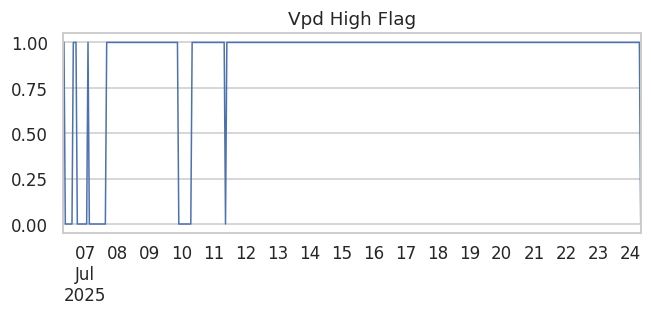
Binary flag (1/0) indicating VPD above predefined stress threshold.
Vpd Kpa
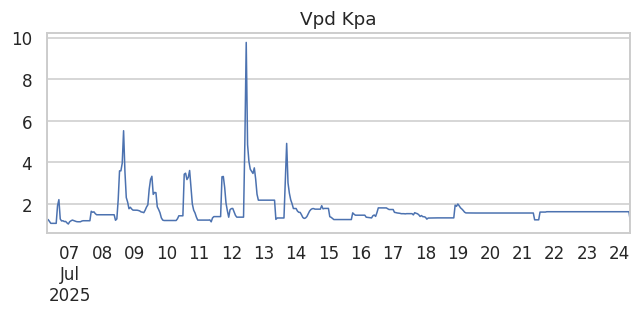
Vapour‑Pressure Deficit (kPa). Higher VPD = faster plant water loss.
Watered Now
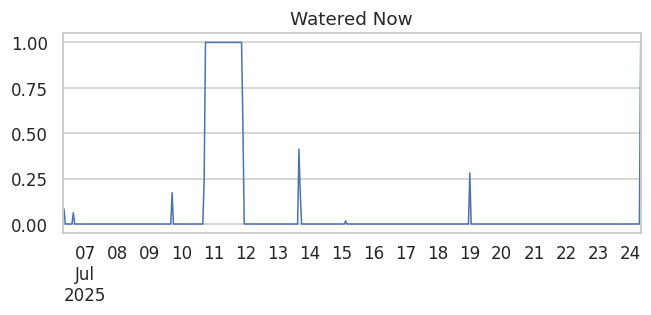
Binary flag marking irrigation events recorded by the controller.
📊 🪴🔆 7
Custom Insight
Insert your additional research or tips here for this cycle of four charts.
Wet Bulb C
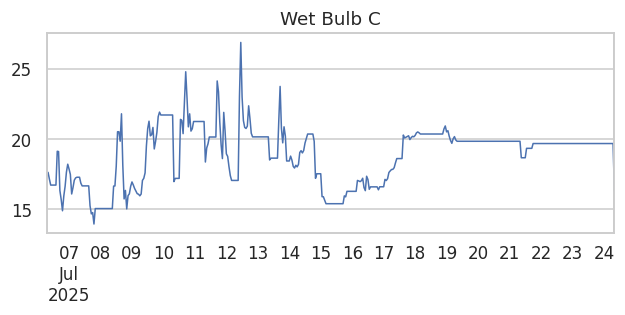
Psychrometric wet‑bulb temperature – proxy for evaporative cooling.
Wsi2025
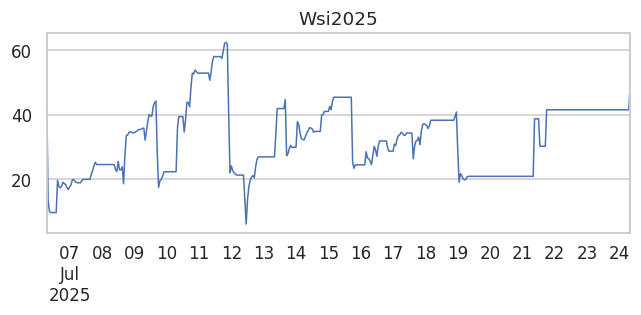
Water Stress Index (2025 model) – composite drought severity score.
References
- Adeyemi, O., Grove, I., Peets, S., & Norton, T. (2018). Advanced monitoring and management systems for improving sustainability in precision irrigation. Sustainability, 10(10), 3535.
- Ferrández-Pastor, F. J., García-Chamizo, J. M., Nieto-Hidalgo, M., Mora-Pascual, J., & Mora-Martínez, J. (2016). Developing ubiquitous sensor network platform using Internet of Things: Application in precision agriculture. Sensors, 16(7), 1141.
- Mittelbach, H., & Seneviratne, S. I. (2012). A new perspective on the spatio-temporal variability of soil moisture: Temporal dynamics versus time-invariant contributions. Hydrology and Earth System Sciences, 16(7), 2169–2179.
- Pham, X., & Stack, M. (2018). How data analytics is transforming agriculture. Business Horizons, 61(1), 125–133.
- Ray, P. P. (2017). Internet of things for smart agriculture: Technologies, practices and future direction. Journal of Ambient Intelligence and Smart Environments, 9(4), 395–420.
- Taylor, S. J., & Letham, B. (2018). Forecasting at scale. The American Statistician, 72(1), 37–45.
- Vereecken, H., Huisman, J. A., Bogena, H., Vanderborght, J., Vrugt, J. A., & Hopmans, J. W. (2014). On the spatio-temporal dynamics of soil moisture at the field scale. Journal of Hydrology, 516, 76–96.
- Wolfert, S., Ge, L., Verdouw, C., & Bogaardt, M. J. (2017). Big Data in smart farming–a review. Agricultural Systems, 153, 69–80.